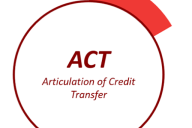You have /5 articles left.
Sign up for a free account or log in.
Invisibility continues to define transfer students’ experience, despite their presence in numbers: a quarter of students at public four-year colleges nationwide are transfers, and approximately one-third of undergraduates transfer at least once between colleges.
Recent research, including student and faculty surveys conducted by our A2B (associate to bachelor’s degree transfer) colleagues at CUNY (where there are up to 25,000 new transfer students per year), reveal some of the reasons underlying this invisibility:
- Faculty are unaware of the particulars of the transfer process: “Even in a system such as CUNY that was built for transfer, many faculty know very little about transfer policies, practices and student outcomes.”
- Students, generally, do not understand transfer policies and rely on websites that “can be woefully lacking in good, comprehensive information about transfer.”
- Advisers are insufficient in number at most public colleges: At CUNY, for example, advisers have caseloads of up to 1,000 students and there are even fewer, if any, dedicated solely to transfer students who need differentiated support from first-time freshmen.
More broadly, the transfer student experience is defined by a bureaucratic system and social culture structured around the first-time freshman experience, which contributes to far too many students never realizing their goal of a bachelor’s degree. A key issue is credit loss: nearly half of students transferring from two-to-four year colleges within CUNY, for example, lose an average of 10.5 credits, which equals almost a semester’s worth of full-time classes.
A Solution: Positioning College Students to Expand Advising Capacity
Streamlining and improving the transfer process at public institutions has come to the fore as a critical equity lever because students with fewer resources are more likely to enter the higher education landscape at two-year colleges. At CUNY, creating innovative web-based tools that help transfer students evaluate their course equivalencies and making transfer policies more visible have been part of the institutional response. This work is critical to increasing persistence and completion rates, however, transfer students need more: they need navigational and relational advising to help them benefit from these resources.
At College Access: Research and Action (CARA), we have developed a peer-to-peer model that expands advising capacity at public institutions by training and positioning college students to support their peers through obstacles to persistence. Trained in the systems and policies of their institution, and supervised by professional staff, paid peer advisers use navigational strategies and relational support to connect students to campus resources.
|
Peer Advisers Receive: |
Campuses Receive: |
|
|
With funding from the Caroll and Milton Petrie Foundation, CARA has collaborated with CUNY’s Brooklyn, Queens, John Jay and Lehman Colleges to tailor our peer-to-peer model to a transfer population. Peer advisers, who often themselves were transfer students, receive 70 hours of training and site-based supervision to work with caseloads of 100 to 125 new transfer students towards both enrollment and persistence. They provide students with information about tools and resources—and then support them to use and benefit from those resources in navigating “leak points” of the transfer pipeline:

Having been transfer students themselves, peer advisers know what transfer students need—navigational and relational support. One explained, “The biggest thing I have struggled with is motivation, so coming into this, I wanted to be there for the procedural, but also for how to help when a student is having a hard time moving forward.”
Campus advisement staff recognize the unique role peer advisers play in meeting students’ needs. One explained, “There are so many tools students can use, [but] peer advisers reshape advisement in terms of the human touch and responsiveness. We are trying to be less reactive and more proactive, and the peer advisers are part of that.”
Case Study: Bite-Sizing, Navigating and Relating at Queens College
At Queens College, three peer advisers, supervised by full-time staff, were assigned caseloads of 100 to 125 undeclared transfer students. The advising department chose to focus on undeclared students for two main reasons: they are not connected to a departmental adviser and they need support to identify their pathway through their B.A. Peer advisers were assigned to students through a process that matched students’ self-declared programs of interest with peer adviser experience in those areas.
Peer advisers used several strategies to support students. One was translating and organizing the diverse array of information transfer students receive at a rapid-fire pace. “We have to think about the illusion of information we think students are getting when they come here,” one campus adviser explained. She went on to name the value of peer advisers “bite-sizing” information for students and disseminating it on a weekly basis through Slack, Microsoft Teams, text messages and other platforms easily accessible to students.
They also helped students navigate using those resources: “Getting through the bureaucracy … how to submit things … financial information, using CUNYFirst to search and then declare their major, setting up meetings with major advisers and general advisers—pointing them in the right direction for every resource.”
Equally important to this information and navigational support, peer advisers tapped into their unique understanding of the emotional experience of transfer students. They tried to “ease the panic” students often feel when they cannot get what they need: “A lot of students are just anxious to have their voices heard … There are just a lot of situations where a student really wants an answer and is frustrated … [they] come back [to us] knowing it is a good place to ask questions and get answers … We can say, it’s in there—it’s being processed—we can clarify what the hold is and say, ‘don’t drop classes.’”
Notably, this work is also transformative for the peer advisers themselves who receive critical career development that builds transferable technical and communication skills. The role also provides a professionalized experience for those interested in pursuing counseling, advising or other careers in higher education. Our data on outcomes for peer advisers indicate they persist and graduate in greater numbers than peers with similar characteristics who did not work as peer advisers, and we know many stay in the field as full-time advisers in higher education or in community-based settings.
Conclusions: Peer Advisers as Leaders in Transfer Policy and Practice
Peer-to-peer advising models where college students are paid to support their peers on campus are proliferating, with our data showing students served by peer advisers persist in college at a rate 11 percent higher than matched comparison peers.
In order to scale peer-to-peer advising models, at CUNY and elsewhere, public college systems need to:
- Establish dedicated sources of pay for the peer advisers;
- Ensure comprehensive training is available, campus-based or through an outside provider;
- Position campus student support/advising staff to supervise the peer advisers;
- Embed peer adviser work streams into existing support initiatives;
- Connect programming to the college’s work-based learning/internship offices;
- Create opportunities for peer advisers to collaborate with and provide feedback to campus personnel about transfer and other policies.
In the transfer pipeline, peer-to-peer advising models render visible transfer students and the institutional supports that exist to help them; and in turn, peer advisers become leaders of practice and advocates for change. Sustaining and spreading this work is a powerful way to address issues of equity that lay beneath and above the surface at public colleges.
Leigh McCallen is director of research and evaluation at CARA. Lori Chajet is co-founder and co-director of CARA. Shalema Henderson is director of peer-to-peer persistence programs at CARA. College Access: Research and Action is based at the CUNY Graduate Center and brings together programming and research to ensure first-generation college students, low-income students and students of color have the knowledge and support necessary to enroll in and persist through college.


